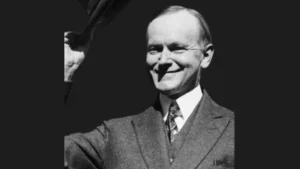Coolidge Had the Right Recipe for National Success
A century ago, the American political scene was defined by a marketplace of ideas that emphasized limited government and personal freedom. At the heart of this era was President Calvin Coolidge, who embodied the principles of restraint and laissez-faire governance. His presidency during the Roaring Twenties laid the groundwork for a period of unprecedented economic growth and prosperity in the United States. Coolidge’s policies of fiscal responsibility and limited government intervention provided a recipe for national success that remains relevant today.
The Coolidge Era: A Commitment to Limited Government
Calvin Coolidge, often referred to as “Silent Cal” for his reserved nature, assumed the presidency in 1923 after the sudden death of President Warren G. Harding. Coolidge’s administration was marked by a dedication to the principles of limited government and free-market capitalism. He believed in the importance of restricting the federal government’s role, allowing the American people and businesses to thrive without undue interference.
One of Coolidge‘s most significant contributions was his tax policy, which aimed to dismantle the tax system established to fund World War I efforts. He implemented broad tax cuts that incentivized economic productivity and encouraged private investment. These tax reductions fostered an environment conducive to entrepreneurship and savings, fueling an economic boom characterized by rapid industrial growth and technological innovation. By keeping the federal government out of the private sector, Coolidge created a fertile ground for prosperity.
Moreover, Coolidge was a proponent of fiscal responsibility. Between 1923 and 1929, he consistently reduced the federal budget, ensuring that government spending remained within reasonable limits. This approach minimized the federal deficit and reinforced the notion that government should live within its means. Coolidge’s fiscal policies resonated with the American populace, contributing to his electoral success and cementing his legacy as a champion of limited government.
The Political Landscape of the 1920s
The 1924 presidential election serves as a testament to the widespread appeal of Coolidge’s philosophy of limited government. Running as a Republican, Coolidge faced opposition from both the Democratic Party and a third-party candidate from the Progressive Party. Despite these challenges, Coolidge secured one of the largest electoral victories in American history, underscoring the public’s endorsement of his approach.
At that time, the Democratic Party was advocating for increased state power to enforce regulations, some of which had underlying racial and segregationist motives. Meanwhile, the Progressive Party, led by Robert M. La Follette, proposed radical measures such as higher progressive taxes and state ownership of key industries. However, the American electorate viewed these proposals as too extreme, favoring the moderation and classical liberalism championed by Coolidge. As a result, the Democratic Party’s moderate candidate, John W. Davis, failed to gain traction, and the election became a resounding affirmation of limited government as the political consensus of 1924.
A Century of Change
Fast forward to 2024, and the political climate has shifted dramatically. While the institutional framework remains intact, political leaders today generally favor increased government intervention in private affairs. Issues ranging from healthcare and education to environmental policy and economic regulation are often approached with an emphasis on expanded government oversight and control.
This shift can be traced back to the Great Depression and the subsequent rise of the New Deal under President Franklin Delano Roosevelt. In response to the economic challenges of the 1930s, the federal government expanded its role significantly, implementing a range of programs and regulations aimed at stabilizing the economy. Since then, the trend toward larger and more interventionist government has continued, often driven by the belief that government action is necessary to address societal issues.
The 1924 Election: A Triumph of Limited Government
The 1924 presidential election was a pivotal moment in American political history, highlighting the widespread appeal of Coolidge’s philosophy of limited government. Running as a Republican, Coolidge faced opposition from both the Democratic Party and a third-party candidate from the Progressive Party. Despite these challenges, Coolidge secured one of the largest electoral victories in American history, underscoring the public’s endorsement of his approach.
At the time, the Democratic Party advocated for increased state power to enforce regulations, some of which had underlying racial and segregationist motives. Meanwhile, the Progressive Party, led by Robert M. La Follette, proposed radical measures such as higher progressive taxes and state ownership of key industries. However, the American electorate viewed these proposals as too extreme, favoring the moderation and classical liberalism championed by Coolidge. As a result, the Democratic Party’s moderate candidate, John W. Davis, failed to gain traction, and the election became a resounding affirmation of limited government as the political consensus of 1924.

The Shift in Political Attitudes
Fast forward to 2024, and the political climate has shifted dramatically. While the institutional framework of the Electoral College and the two-party system remains intact, political leaders today generally favor increased government intervention in private affairs. Issues ranging from healthcare and education to environmental policy and economic regulation are often approached with an emphasis on expanded government oversight and control.
This shift can be traced back to the Great Depression and the subsequent rise of the New Deal under President Franklin Delano Roosevelt. In response to the economic challenges of the 1930s, the federal government expanded its role significantly, implementing a range of programs and regulations aimed at stabilizing the economy. Since then, the trend toward larger and more interventionist government has continued, often driven by the belief that government action is necessary to address societal issues.
Lessons from Coolidge’s Legacy
As the nation reflects on the centennial of Coolidge’s 1924 election, there are valuable lessons to be learned from his legacy. Coolidge’s administration demonstrated that limited government and respect for individual liberty can create an environment conducive to prosperity and innovation. By empowering state and local governments while restraining federal overreach, Coolidge’s policies enabled Americans to harness their entrepreneurial spirit and achieve unprecedented economic growth.
In today’s political discourse, revisiting the principles of limited government may offer insights into how to balance governmental authority with personal freedom. As both political parties prepare for the upcoming elections, Coolidge’s approach serves as a reminder that sometimes, less government intervention can lead to greater national success. The centennial of his presidency encourages reflection on the enduring value of limited government in shaping the future of the United States.
Conclusion
Calvin Coolidge’s presidency during the Roaring Twenties exemplified the benefits of limited government and fiscal responsibility. His policies of tax reduction, budget cuts, and non-interventionist governance provided a recipe for national success that continues to resonate a century later. As America faces new challenges and debates the role of government in society, Coolidge’s legacy serves as a testament to the enduring power of limited government in fostering prosperity and freedom.




